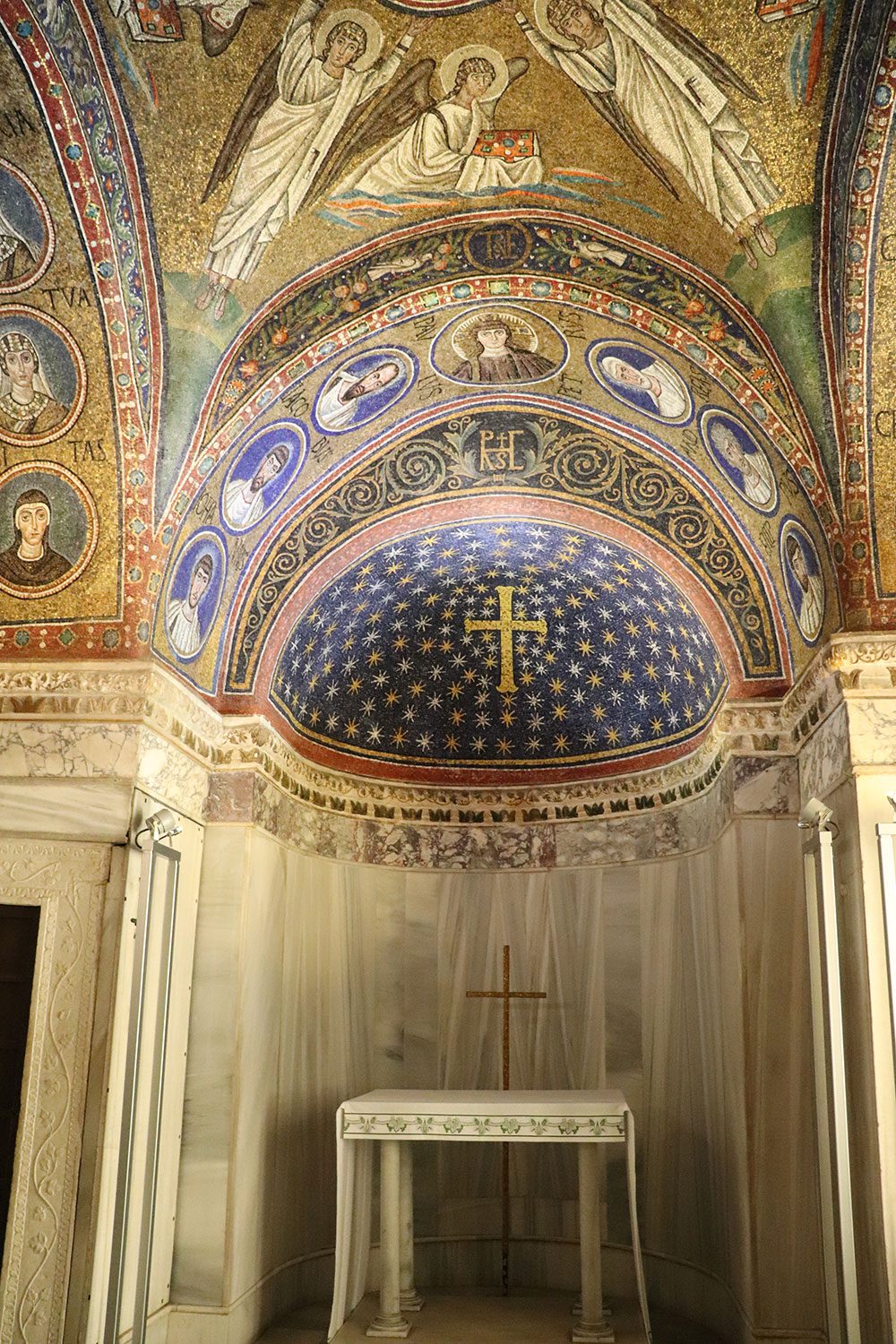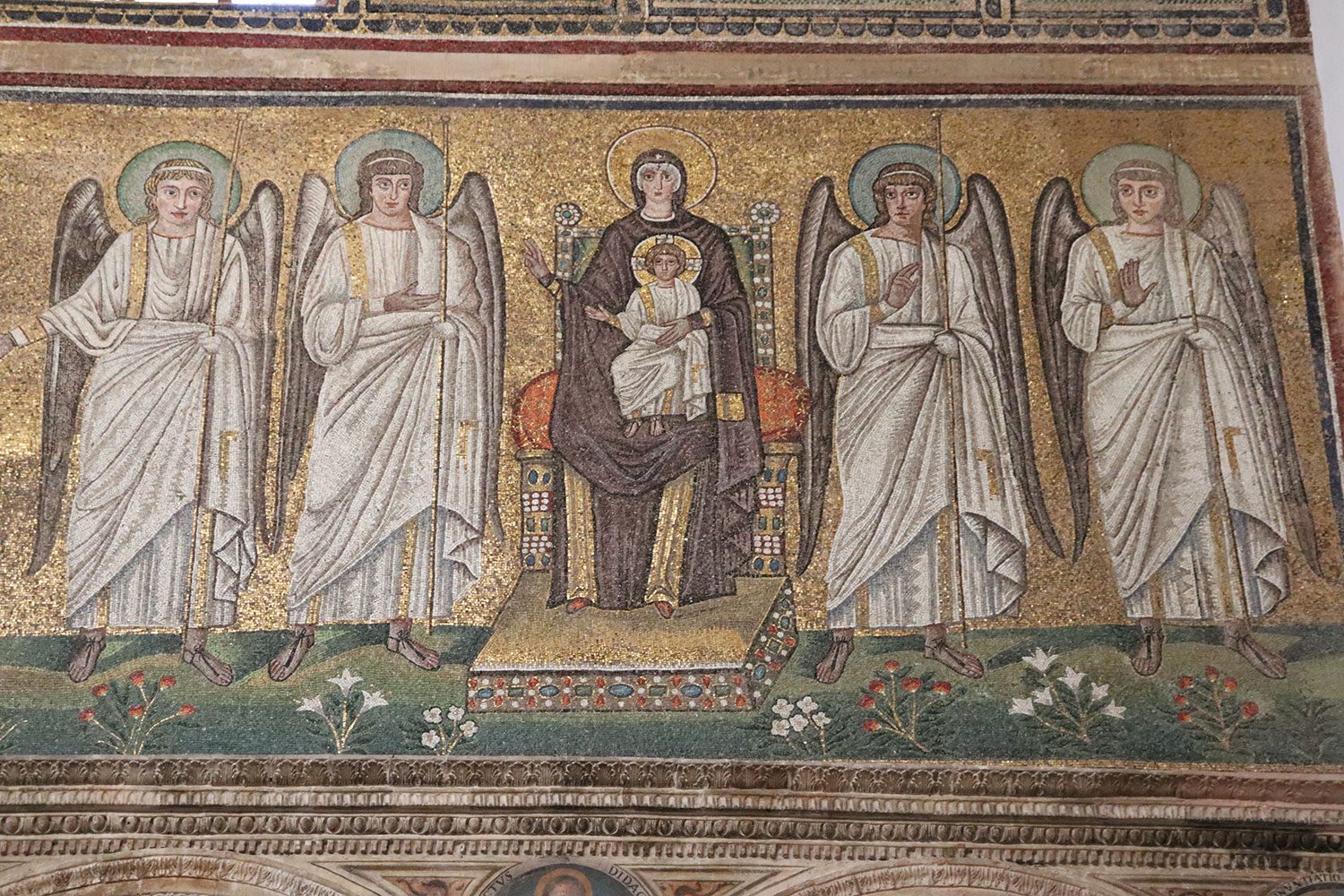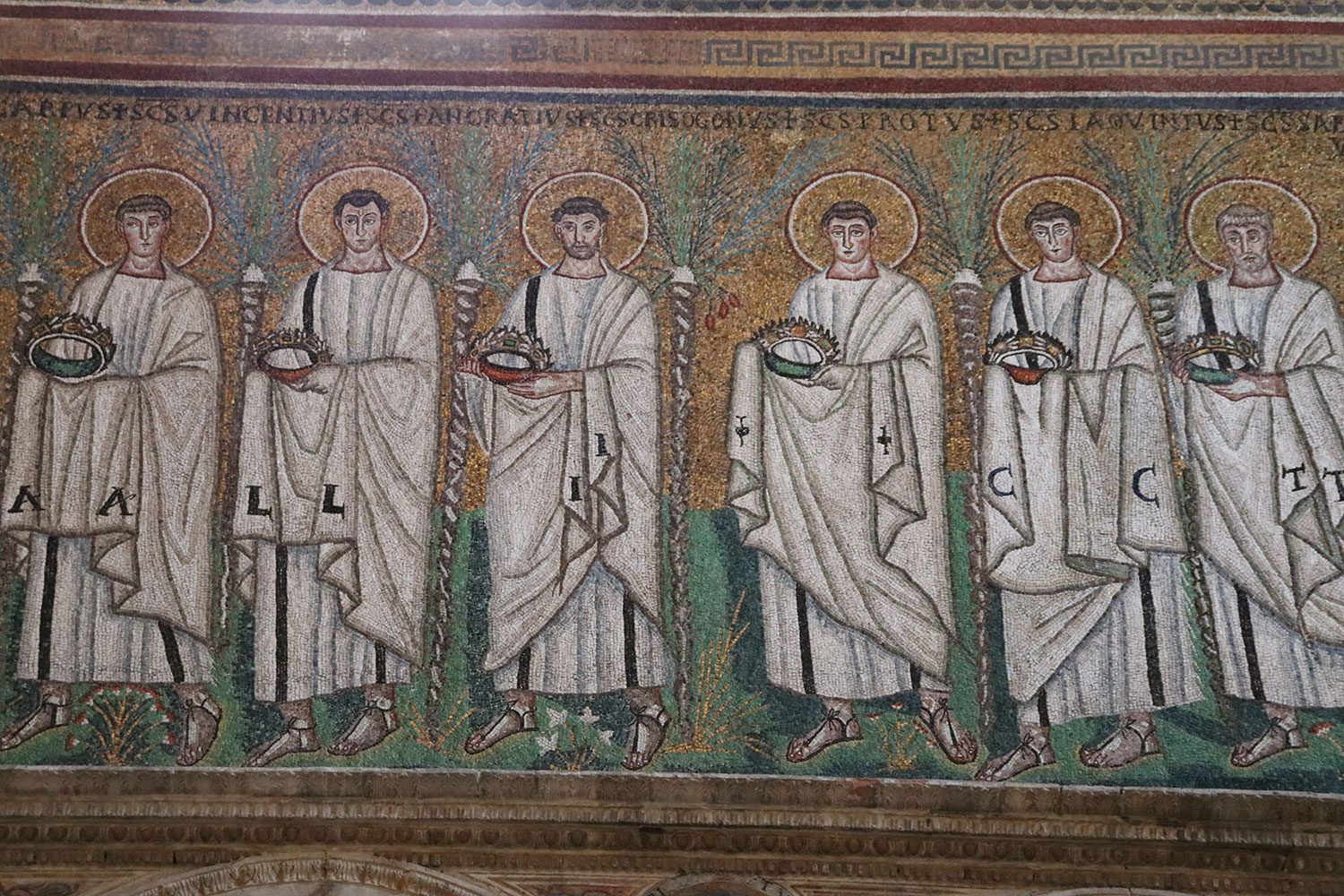Ravenna, Italy: the Stunning City of Mosaics – Things to Do & Travel Guide
Last updated on April 8, 2023
If you’ve taken art history then you may be very well aware of the mosaics of Ravenna, Italy. They’re surviving and absolutely stunning remnants of early Christian art. I am absolutely floored by the amount of work that goes into making mosaics, nevertheless the age of those in Ravenna – which are about 1500 years old and older! There’s nothing like this to be seen in the rest of the world, making Ravenna a truly unique destination.

The History of Ravenna
Around the time of Christ, Ravenna and its area Classe were actually important seaports. It’s hard to see now because the town is now about 6 miles away from the coast. Ravenna even became the capital of the Roman Empire in 408, shortly before the fall of the Empire. It then served at capital of the Kingdom of Italy in Ostrogothic times. About a century later it became part of the Byzantine Empire and served as the seat of Italy. It is during the Ostrogothic and Byzantine rule that the mosaics of Ravenna were completed. The town has since been part of the Holy Roman Empire and Venetian Empire, amongst others.
Today Ravenna is a part of the Emilia-Romagna region of Italy.
The Mosaics of Ravenna
Today you can visit seven buildings that have these mosaics. They are all part of Ravenna’s UNESCO World Heritage Site status and five of them are available on the same ticket.
There are many guides that will show you the mosaics and explain what’s being depicted in them. Of course it’s an added cost but a great way to see the sights. Make sure to check which buildings the tours cover before booking to make sure you’ll get a guide for what you are particularly interested in.
Arian Baptistery
The Arian Baptistery is the first stop on this list and dates to about the 5th century. (Arianism is a type of Christianity, by the way, and not to be confused with the racist term.) The Baptistery has its own ticket available for purchase just outside the structure. Also note that it usually closes around noon, so be sure to get there early!


It’s also one of the simplest places on this list, consisting of a single octagonal structure with a single large mosaic on the domed ceiling. It depicts the Baptism of Christ and has the twelve apostles. There apparently used to be adornments on the walls but that’s all gone now, unfortunately. But when there are so many structures in Italy with so much going on, it’s a bit of a nice breather to see something simpler but still so beautiful. An unrivaled focus.

These photos really don’t do any of the mosaics real justice, particularly of the Arian Baptistery, because you can’t see their shimmer. The colors look dull but it’s actually a very bright and almost interactive experience to see the mosaics in person. There’s only one scene in the Baptistery but I could’ve spent more time looking at it. Its beauty is in its simplicity but also the incredible amount of work and detail that went into creating a single piece.

All the structures are very bland on the outside, by the way, hiding their shimmering contents. If you didn’t know anything about Ravenna and walked into any one of these buildings, it would be quite a pleasant surprise.
Mausoleum of Galla Placidia
Galla Placidia was the daughter of Roman Emperor Theodosius I. The myth is that she’s buried there but that’s probably not true, and it’s now believed the mausoleum holds her name because she was the patron of it. The structure dates to around the early to mid 5th century.




What I found so lovely about the mausoleum’s decoration is it’s so calming – which is appropriate for a mausoleum. The ceiling tiles are a beautiful dark blue with a star-like pattern, emulating a night sky. Some images you can see in the tiles include Christ the Shepherd and his flock; drinking deer; a male saint with a cross and the four canonical gospels; and some apostles. Appropriately, the theme is the triumph over death with the belief in Christ.



Unlike the other structures, what makes the Mausoleum so special is its darkness. It has only a few small windows which are now covered with alabaster. Today there are only a few small lights to illuminate it, just as there might have been centuries ago. It’s stunning to see the beautiful tiles sparkle out of the darkness. It was definitely one of my favourite stops in the city.
The Mausoleum of Galla Placidia can be visited with the combined Ravenna ticket, which you can buy at a few locations throughout the city (one’s right next to the mausoleum).
Basilica of San Vitale
You can also visit the Basilica of San Vitale with your combined Ravenna ticket.



The basilica was consecrated sometime in the mid 6th century and is chillingly enough supposed to be on the site of a murder. The legend goes that San Vitale (the saint after whom the basilica is named) witnessed another saint’s execution – Saint Ursicinus. He took Saint Ursicinus’ body away to bury it and was caught, then thrown into a well and covered with stones. The church is said to be built on that well.



What makes San Vitale special is its octagonal structure emblematic of early Christian architecture, but what makes it sparkle is the decoration of its rectangular apse. There are so many scenes to see here, notably the ones of Justinian and Theodora with the liturgical procession. There’s also the main depiction of Christ and San Vitale; Abraham feeding the three angels; the sacrifice of Isaac; Abel and Melchizedek; and many more. The ceiling has the Lamb of God and the main arch has depictions of Jesus, the apostles, and the sons of San Vitale.



San Vitale was definitely my favourite place to visit in Ravenna. The colors in particular grab my attention, but of course the beauty of the mosaic design and way it’s all placed is so stunning. It’s also one of the biggest spaces covered in Ravenna. I could’ve spent hours there. San Vitale is just perfect.
The dome was also beautifully painted in the 18th century, though it is of course very different from the star mosaics.
Neonian Baptistery
This is the third structure you can see with a Ravenna ticket. The Baptistery was decorated by Bishop Neon in 452, which is how it goes its name.


Not as simple as the Aryan Baptistery but less so than the Mausoleum and Basilica, the Neonian Baptistery’s mosaics cover its domed ceiling. There’s a depiction of the Baptism of Christ; the twelve apostles; and altars with gospels. I thought the altars were particularly interesting as I did a research paper on the depiction of interiors in medieval stained glass. Interior decor is not often seen by itself.


What makes the Baptistery unique is the stone decoration that divides the mosaics. Apparently it is original – the Baptistery is said to be the best preserved of the buildings in Ravenna. The decoration looks ancient Roman but I thought perhaps they had been added later, which is not the case. There are also a few shrines to the prophets at eye level.



The Baptistery has a darker colour palette but it’s not a very dark space. The windows bring in lots of light so it’s similar but a lot less intimate than the Mausoleum. I think of all the structures, the Baptistery is probably the most unique.
Archbishop’s Chapel of St. Andrew
It has many names, including the Sant’Andrea (St. Andrew’s) Chapel; Archiepiscopal Chapel; and Archbishop’s Chapel.
Your Ravenna ticket can also get you into it, which is actually located in a museum. Present your ticket to be admitted to the museum and you’ll find the chapel on the first floor. (If you stay longer, the museum has some more ancient artefacts to see.)



The chapel dates to the late 5th/early 6th centuries but it was heavily restored to what historians believe was its original appearance. You first enter a richly decorated narthex that has a ceiling decorated with birds. A warrior is depicted on the wall and I thought it was just a saint but apparently it’s Christ. Interesting as I’ve seen very little art depicting him in armour. The interior of the chapel has the evangelists and apostles. The chapel was intended for private prayer so of course it’s a lot smaller than the other structures, but I like how intimate it feels. You can see the mosaics a lot more closely.



The rest of the museum is a bit small and I found it rather uninteresting but of course it’s there to explore. Apparently it used to be a Bishop’s Palace but was completely revamped, which is why an ancient chapel is in a seemingly modern building.
Basilica of Sant’Apollinare Nuovo
This is the last place you can get into with your Ravenna ticket, and the last place on this list in Ravenna city. The Basilica dates to the very beginning of the 6th century and the mosaics around the same time period. Unlike the octagonal floor plans of Ravenna’s other buildings, Sant’Apollinare Nuovo has a rectangular floor plan.
Apparently the “Nuovo” (“new”) in the name is comparing this basilica to another basilica of Sant’Apollinare that used to exist in Ravenna city, not the one out in Classe (below).



There’s a lot of real estate covered by the mosaics, so there’s a lot to see. There are scenes of Christ’s life and miracles along the top band of mosaics but honestly, they’re high up in person so it’s a bit hard to see them. And like the other buildings of Ravenna, there are many depictions of the saints, evangelists, and prophets.

The sides are then divided by genders. One one side, a group of female virgins makes their way to the Virgin and Child enthroned. On the other side, a group of male martyrs moves towards Christ enthroned. You can spend a lot of time in the church looking at each individual piece of the mosaic.
Sadly, the mosaics on the apse were destroyed, so the only mosaic decoration exists around the sides of the church.




Even though it’s somewhat incomplete, Sant’Apollinare Nuovo is probably my second favourite. I really like how much is happening in the mosaics and enjoyed spending a lot of time there, looking at all the individual pieces and trying to figure out what it was all depicting.
Basilica of Sant’Apollinare in Classe
The Basilica of Sant’Apollinare in Classe is not in downtown Ravenna but rather a few miles away in “Classe.” The church is also not a part of the combined ticket. You can easily reach it by bus, which is about a 15-20 minute ride. Apparently this was the port town that was depicted by the boats in the mosaics above – which I didn’t understand because Ravenna is about 6 miles away from the coast. It’s amazing how much the world has physically changed over the centuries.



The basilica was built in the early 6th century and is the opposite of Nuovo in that the apse is the only part of the church with mosaics. It depicts Christ the Good Shepherd with his lambs (apostles) and the four evangelists. Moses, Elijah, and the Hand of God can also be seen coming down seemingly from above.


What’s particularly stunning about these mosaics are the colors. Here we have the beautiful green seen in San Vitale but also an incredible amount of shiny gold. Apparently the gold used in these mosaics is real gold rather than gold leaf, so you can imagine how much one mosaic alone might be worth.
I had just enough time for a quick look so I went ahead and hurried on down. While the church is beautiful, it’s nothing more amazing than what you can see in downtown Ravenna. I was pressed for time so my visit was a bit stressful, which I don’t recommend for anyone. If you can make it down, then great! I definitely recommend doing so. If not, don’t worry about it. You can still see so many marvels in the main part of town.
(But if you have a full day in Ravenna then yes, you can probably make it. More on that below.)
Other Things to Do & See in Ravenna
The seven aforementioned structures make up the UNESCO World Heritage Site of Ravenna with an additional building: the Teodorico Mausoleum. It’s the mausoleum of Theodoric the Great and dates to the 6th century but it’s a bit of an ugly and bare building. The structures are tied together as being early Christian monuments but the Teodorico Mausoleum doesn’t have any mosaics.
Next to Sant’Apollinare Nuovo is the Palace of Theodoric, which is a ruin now but quite interesting to see.
Dante Alighieri, writer of the Divine Comedy, is one of the most celebrated people in Italy today. He died in 1318 during a visit to Ravenna and was subsequently buried there. His tomb is out and open to public, and dates a bit later to 1483. If you want to learn a more about Dante, you can hop on over to the nearly Museo Dante.



It’s next to the Basilica of San Francesco, where he was originally buried. The church is unremarkable on the inside but you can go down to see the flooded crypt. You can also visit the Church of St. Euphemia to see a collection of Byzantine floor mosaics called Domus dei Tappeti di Pietra – “House of the Stone Carpets.”
If you’re spending more time in Ravenna then you might be interested to see the Ravenna Art Museum or the National Museum of Ravenna.


Ravenna’s a very cute town in its own right. There’s a ton of shopping and it’s very laid back. Since a lot of people come only for the mosaics, the town is very local and fairly free of tourists walking about. It’s a nice break from other places in Italy.
One thing I thought was particularly fun was taking a mosaics class. I took a two-hour class with Koko Mosaico, which is a great company. They use the ancient technique to make their mosaics and they are very talented. The class will show you how to cut the marble and then you get to make a small mosaic from a pre-drawn design. I thought it was fun and now have a souvenir I made myself, but it’s definitely on the expensive side. It’s something to consider if you have a bigger budget.


Ravenna’s a small place and if you don’t go on a group tour, you can see the six main structures quite quickly. If you spend about 20 minutes in each, that’s still only 2 hours to see them all, and the walking distance between them isn’t far. If you’re pressed on going to Classe then I’d add another 2 hours just to be stress-free. Of course, you’ll want to build in time to walk around, eat, maybe see some other sights and museums. Long story short, you can see Ravenna in a half day or a full day depending on how much you want to do.
I did my visit as a day trip from Florence and even though it was a three hour train ride each way, I felt it was very much worth seeing these magnificent structures. They’re unique and beautiful pieces of art that should be seen in person to really appreciate.
So if you’d like to see Ravenna, I’d definitely recommend doing yourself the favour and going to see it. It is a magnificent place.
About the Author
My name's Lilly and I'm a Baltimore-based travel blogger with a focus on art and history. I work full time and manage to get in several trips a year. Learn more about me.Tags: europe, italy, ravenna
Sharing is Caring
Want to support me?
 Buy me a Coffee
Buy me a Coffee














